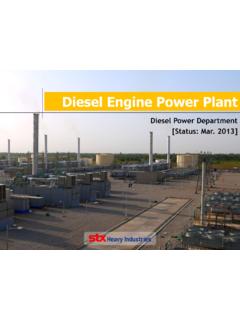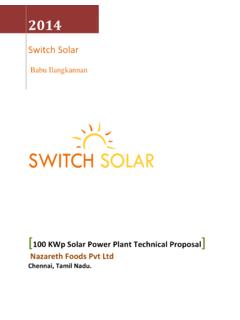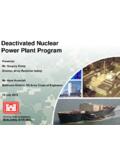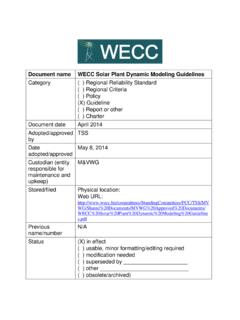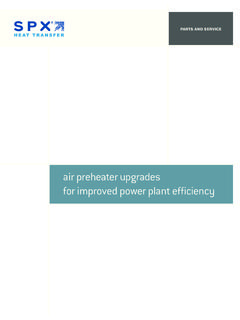Transcription of Financial Analysis of Solar Photovoltaic Power plant in India
1 IOSR Journal of Economics and Finance (IOSR-JEF) e-ISSN: 2321-5933, p-ISSN: 2321-5925 PP 09-15 International Conference on Innovative Management Strategies 9 | Page Madanapalle Institute Of Technology & Science, Bangalore, India Financial Analysis of Solar Photovoltaic Power plant in India M. Ganga Prasanna, S. Mahammed Sameer, G. Hemavathi Department of Management Studies MadanapalleInstitute of Technology& Science Post Box No: 14, Angallu, Madanapalle -517325, AP., India . Abstract: Solar Photovoltaic (PV) Power systems for both utility as well as roof mount applications growing rapidly in India . Solar Power plants in India till date are mostly ground-mounted Power plants . Most of the utility scale PV Power plants are typically in the scale of 5 MW in size and connected to the electrical grid.
2 The objective of this study is to present the Financial feasibility of 100 KW roof top Solar PV Power . State of art technology of Solar PV modules, Power electronics with fixed mounted array is considered for an educational institute. Presently the institute is using utility Power and also diesel generator to backup for Power outing. Financial Analysis has been performed with present system cost based on life cycle cost of energy. Standard Financial procedures have been used and the sensitivity parameters studied, mainly focusing on various factors, Solar insolation variability at the site, the Financial interest rates and operational and maintenance cost. The feasibility Analysis results were discussed and presented in the conclusions. Keywords: Photovoltaic , Financial feasibility, Financial Analysis , Insolation variability I.
3 Introduction: The energy consumption of India is now soaring and may face severe electricity shortages in the near future. India needs a sustained growth rate of 9 to 10% over the next twenty years to meet ]its growth objectives. This implies that it will need to increase its primary energy supply buy a factor of three to four and to the electricity generation by a factor of five to six . India receives nearly 300-330 days of Solar energy and there is a large potential available for generating Solar Power using unutilized space on rooftops of individual houses , industrial buildings ,commercial buildings, educational institutes or any other type of buildings can be used to moderately fulfill the requirement of the building occupants and excess , if any , can be fed into the grid . So the best suitable long term design solution for India would be highly distributed set of individual rooftop Power generation systems connected through a local grid.
4 In grid interactive rooftop Solar PV Power systems , the DC Power generated from Solar panel is converted to AC Power using Power conditioning unit and is fed to the grid .The generated Power during the day time can be utilized fully by powering locked upmany and excess can be fed to the grid as long as grid is available .In case , were Solar Power is not sufficient due to cloud cover or during the cloudy hours , the captive loads are served by drawing Power from the grid interactive rooftop Solar system can work on net metering basis where in the beneficiary pays to the utility on net meter reading basis only. The main objective of present paper is to present the Financial Analysis of 100 KW rooftop Solar PV Power systems for both with and without battery support. The sensitivity Analysis of the various cost elements have been studied and identified to look in for future reduction.
5 The results were presented and the conclusions were drawn. II. Solar PV Power system status in India : In India , the Solar market is undergoing changes from the incentive driven market to parity driven market. But this change is creating problem to policy makers and creating delays in policies. One of the results of this transition is that Indian Solar market is moving from utility market to generation market. Let us expect that 2014 will lay a strong ground for roof top Solar market. To understand the above statement we can take the delays that has been occurring in states like Andhra Pradesh, Tamilnadu, Karnataka, Punjab and Uttar Pradesh that has been continuing in delays different states are facing many litigations and no PPA`s have been signed. On the other side, it is encouraging to see that many central and state governments have announced some policies, subsidies, Feed-in-Tariff`s (FITs) To promote rooftop Solar Power but there may also suffer some delays due to the election paralysis in India .
6 The Solar energy corporation of India (SECI) was providing a capital subsidy for 100MW every year. Due to all the above reasons, we can expect new Solar PV capacity of 750 MW in 2014. IOSR Journal of Economics and Finance (IOSR-JEF) e-ISSN: 2321-5933, p-ISSN: 2321-5925 PP 09-15 International Conference on Innovative Management Strategies 10 | Page Madanapalle Institute Of Technology & Science, Bangalore, India Why off-grid roof top system: By using off-grid rooftop system the customer can have the following advantages. Have access to Power continuously all the time. Not having any scheduled or unscheduled Power cuts. No dependency on diesel The quality of this Power is superior to the regular grid Power . Investment against increasing fuel and grid charges. Application areas: Hospitals Educational institutions Government offices Commercial buildings Petrol pumps Construction companies Water pumps Salient features of off-grid roof top system: Low and optimum maintenance cost.
7 Stable supply of Power increases the overall efficiency of electronic components Can effectively manage usage of Power based on requirements through smart electronics. Batteries designed for longer life. Minimum Power loss with effectively designed DC cables and Junction boxes. What advantages educational institutes have with Solar PV Power system? Self sufficient: By installing Solar PV Power plant in the educational institution it can get a benefit of producing its own and sufficient electrical energy without shortages or scheduled and unscheduled Power cuts. Renewable Energy Corporation: Educational institutes can get a benefit of registering with Renewable Energy Certification which increases the goodwill about the institution. Training and Research: Students can be given some training programs and research projects which increases the capability of the students, which adds as a benefit to the institution.
8 Green energy: Can reduce the carbon gases into the environment IOSR Journal of Economics and Finance (IOSR-JEF) e-ISSN: 2321-5933, p-ISSN: 2321-5925 PP 09-15 International Conference on Innovative Management Strategies 11 | Page Madanapalle Institute Of Technology & Science, Bangalore, India III. Functional Description: Following figure show that various components of Solar PV Power plant for roof top system Key components of Solar rooftop system Solar Panel A Solar panel ( Photovoltaic module) is a packaged, linked group of Photovoltaic cells and it is used as a component of a rooftop system to generate and supply DC electricity). Solar panels generally form a part of a vast Solar array (multiple panels connected together). Each panel is graded by its DC output Power under standard check conditions, and typically ranges between 100 - 350 watts.
9 We have selected 200 watts panels for our system Junction box - An electrical junction box is a connecting box for Solar PV modules for series and parallel electrical connections, usually designed to conceal them from view and tampering. A small metal or plastic connection box may form part of an electrical conduit wiring system in a building, or may be covered in the plaster of a wall, hidden behind an access panel or spread into concrete with only the lid showing. It also includes terminals for combining cables. Its safety degree should be IP65. Inverter ( Power Conditioning Unit) - The Power Conditioning Units (PCU) used in grid connects SPV systems consists of an Inverter and other electronics for Maximum peak Power tracking (MPPT), Synchronization and remote monitoring.
10 The inverter is the most complicated part of the PV system. It has to behave as the interface between the PV array and the Grid. As the PV array output fluctuates with the Solar radiation the inverter has to cope with the same. The major functions carried out by the PCU are as follows: Change the incoming DC received from PV modules into AC with suitable Power quality. TheInverter creates sinusoidal AC waves forms with low harmonic distortion. The inverter also has to act as a protective device of the system. It requires tripping out if thevoltage, current or frequencies go beyond acceptable ranges. We have selected 5 numbers of 20kW each inverter for our plant . Manual/Automatic disconnect switch - It is an automatically/manually operated electrical switch designed to protect an electrical circuit from damage caused by overload or short circuit.











